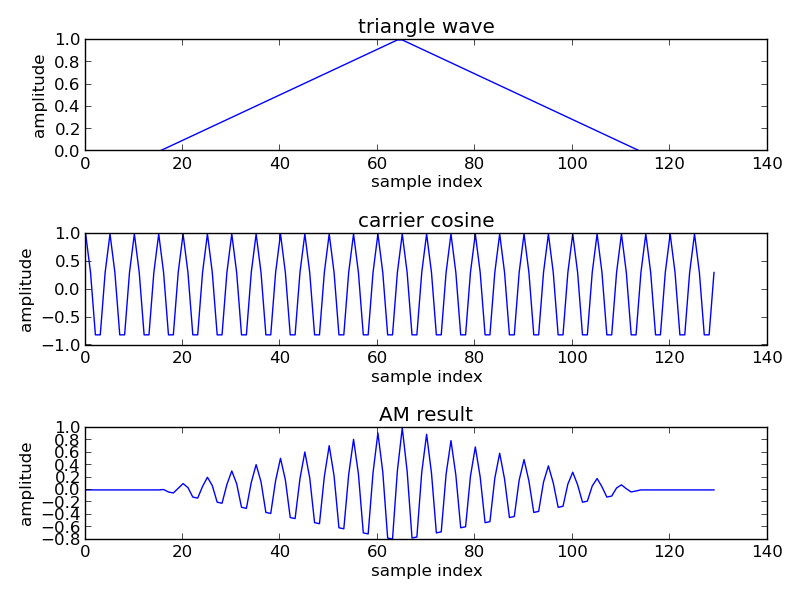I had a hard time thinking about what to write, and I settling with amplitude modulation. So let’s get down to it.
Simply put, amplitude modulation of a signal causes a signal to have sinusoidal fluctuations in amplitude. The simplest form of AM can be shown in this equation, given a signal
is some radian frequency oscillation rate,
is a possible phase offset, and
is obviously time.
I made a plot below that visibly shows the effects of basic amplitude modulation below on a simple triangle wave. Code is available at the bottom of the page. You can see the ENVELOPE of the signal, i.e. the original triangle wave, though it goes positive and negative thanks to the cosine wave. Additionally, in the frequency domain, you can see the fat spike of the triangle wave getting spun up to the frequency of the cosine wave! This is how basic AM radio works, the original signal is spun up to a higher carrier frequency before being transmitted over the air!
Amplitude modulation isn’t described only by the equation above, it’s a blanket term for affecting the amplitude of a signal with a sinusoidal function, so as you can imagine, different applications get different equations for different purposes.
The equation given above has a use in audio effects known as “TREMOLO.” You can buy a tremolo pedal for electric guitars, and a lot of nicer solid-state or DSP-based amplifier systems like Line6’s Spider series generally have a tremolo function built in. The most obvious use of it is in the beginning of Boulevard of Broken Dreams by Green Day, from the 2004 album American Idiot. Aside from arguments concerning musical taste, the simple chord progression makes it very clear what tremolo effects sound like.
In radio, amplitude modulation takes a huge turn into complexity land because of its various applications and uses in both analog and digital radio. The simple equation above is known as double-sideband suppressed carrier, as opposed to double-sideband AM which is like
There are other types of analog AM like single-sideband varieties. Say, single-sideband suppressed carrier with an equation like this:
The varying radio types require different receivers and have different power requirements, not to mention analog implementation of transmitters is also sort of rigid in terms of design. Modern digital communications using pulse amplitude modulation or quadrature amplitude modulation also build on the AM idea, but using a fixed constellation size and flexible parameters, they allow for much more reliable communications than analog methods in general, not to mention basic nice things you get from putting data into bits (forward error correction, etc).
I’m sure there are other useful things that amplitude modulation can do, but those are the two I’m most attuned with.
Oh yeah, the code I promised for making those plots.
# -*- coding: utf-8 -*-
"""
Created on Tue Mar 18 23:46:58 2014
@author: joshua
"""
import numpy as np
import matplotlib.pyplot as plt
# initialize a triangle wave
triangle = np.hstack( (np.zeros(15), np.linspace(0,1,50), np.linspace(1,0,50), np.zeros(15)) )
n = np.size(triangle)
# initialize a cosine wave
the_cos = np.cos(2*np.pi*.2*np.arange(n))
# multiply
the_result = triangle*the_cos
# plot triangle
plt.figure()
plt.subplot(3,1,1)
plt.plot(np.arange(n), triangle)
plt.xlabel('sample index')
plt.ylabel('amplitude')
plt.title( 'triangle wave' )
# plot cosine
plt.subplot(3,1,2)
plt.plot(np.arange(n), the_cos)
plt.xlabel('sample index')
plt.ylabel('amplitude')
plt.title( 'carrier cosine' )
# plot both together
plt.subplot(3,1,3)
plt.plot(np.arange(n), the_result)
plt.xlabel('sample index')
plt.ylabel('amplitude')
plt.title( 'AM result' )
plt.tight_layout()
# save it
plt.savefig('am_demo_1.png')
# plot triangle FFT
plt.clf()
plt.subplot(3,1,1)
plt.plot(np.linspace(0, 2*np.pi, num=n, endpoint=False), np.abs(np.fft.fft(triangle)))
plt.xlabel('freq in radians')
plt.ylabel('magnitude')
plt.title( 'triangle wave in frequency' )
# plot cosine FFT
plt.subplot(3,1,2)
plt.plot(np.linspace(0, 2*np.pi, num=n, endpoint=False), np.abs(np.fft.fft(the_cos)))
plt.xlabel('freq in radians')
plt.ylabel('magnitude')
plt.title( 'cos in frequency' )
# plot both FFT
plt.subplot(3,1,3)
plt.plot(np.linspace(0, 2*np.pi, num=n, endpoint=False), np.abs(np.fft.fft(the_result)))
plt.xlabel('freq in radians')
plt.ylabel('magnitude')
plt.title( 'AM result in frequency' )
plt.tight_layout()
# save it
plt.savefig('am_demo_2.png')

